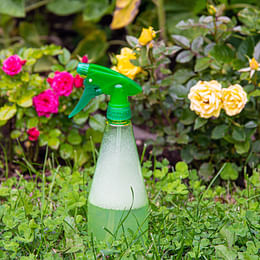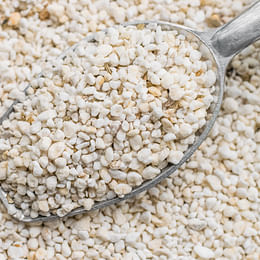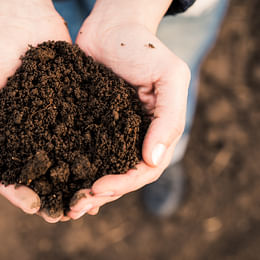How to care for a Golden Pothos
The Golden Pothos is not difficult to take care of, but it might also not be the best plant for beginning plant owners. It requires a fine balance between dry and wet soil and a bright spot in your house. Find out exactly how to take care of this beautiful plant in this comprehensive plant care guide.
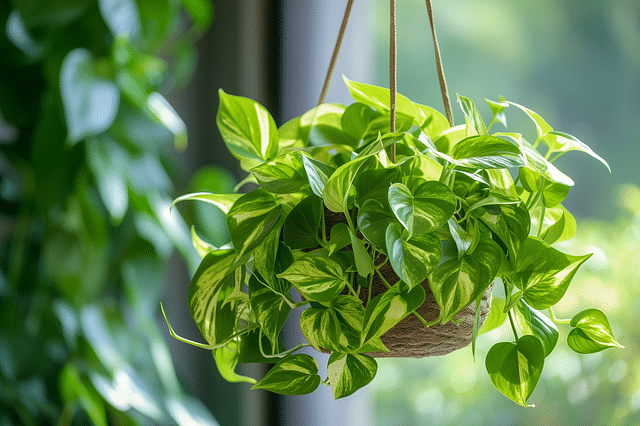
A Golden Pothos is one of those plants that grows quickly and is well-prepared to recover from all kinds of issues.
The Golden Pothos is not difficult to take care of, but it might also not be the best plant for beginning plant owners. It requires a fine balance between dry and wet soil and a bright spot in your house. This means it's a little more involved than plants like a Dracaena, Sansevieria, or a ZZ plant.
To find out exactly how to take care of this beautiful plant, let's break the plant care routine down into a few parts:
Let's get into the first topic: watering requirements!
Watering your Golden Pothos
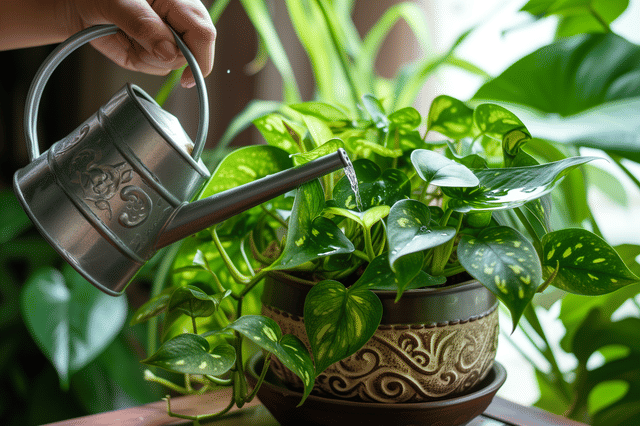
The Golden Pothos is a plant that loves to be in moist soil most of the time. You can let it dry out for a day or two as well, but it shouldn't be dry for much longer than that, as the Pothos doesn't tolerate dry soil very well. The Pothos vines can grow very long, so they prefer a constant supply of moisture to absorb.
I recommend watering your Golden Pothos once every 1-2 weeks, allowing the soil to dry out between waterings. Check the soil before watering by putting your finger into the top inch of soil. If it's wet/moist you don't need to water the Pothos yet. If it's dry, water the plant until the excess runs through the drainage holes.
Your Pothos loves moist soil at all times, but it doesn't tolerate wet soil very well either. Like most other plants, the Golden Pothos can get root rot if it's in wet soil for too long or too often. When the soil is wet, it's very difficult for oxygen to reach the roots of your Pothos, which kills the roots. This will harm the plant, as it won't be able to absorb any more moisture and nutrients.
You can avoid getting root rot by making sure your pot has drainage holes, so the excess water can escape out of the bottom.
Sunlight requirements for a Golden Pothos
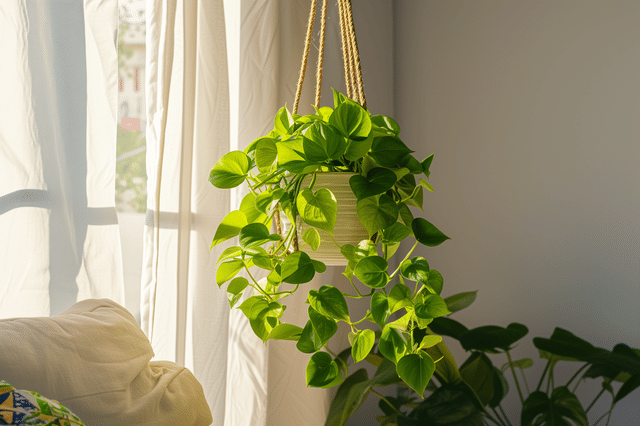
Its plant care routine is very similar to its cousin, the Philodendron. However, where it differs from a Philodendron is that the Pothos likes brighter spots in your house. The Golden Pothos likes bright indirect sunlight. This will keep its leaves strong and healthy. Too little sunlight will cause the leaves to become pale and grow smaller in general. While too much sunlight will cause sunburns on your Pothos' leaves.
If you don't have any bright spots available, that's no problem either, your Pothos will still be able to grow in low-light environments. The only downside is that the beautiful variegation on the leaves will slowly fade. The variegation needs more sunlight to stay bright and pronounced.
Brown spots on the leaves
When your Pothos gets too much sunlight, it'll get sunburns on its leaves. The sunburns will show up on the variegated parts of the leaves most of the time and are unfortunately permanent. Sunburns won't heal, so you could trim the leaf off if you want to.
The ideal growing temperature for a Pothos
The ideal growing temperature for a Golden Pothos is between 20 to 32 Celsius (70-90 F). Your Pothos loves these tropical temperatures. This is quite warm for a normal house, so to achieve this temperature for your Pothos, you can keep it in a bright spot. Just make sure you're not exposing your Golden Pothos to direct sunlight.
Humidity levels for a thriving Golden Pothos
Just like temperature, the humidity level also plays an important role in the health of your Golden Pothos. Originating from tropical forests, this plant does best in higher-humidity environments. Aim for a humidity level of about 50% to 70%.
If you live in a drier climate, you can increase the humidity around your plant by placing a humidifier nearby or creating a pebble tray filled with water under the pot. Remember, maintaining these ideal humidity conditions will help prevent issues such as brown leaf tips and edges, which often signify a lack of moisture in the air. Regularly misting your Pothos can also increase or maintain humidity levels, but be cautious as too much moisture can lead to fungal problems.
The perfect soil for your Golden Pothos
The Golden Pothos likes to be in moist soil at all times. To make it easier for you to give it this growing environment, it's a good idea to get soil that drains excess water away quickly but also holds on to water well. There are premade soil mixes you can get for this, or you can mix it yourself. If you're looking to get a premade mix, you can get a palm/tropical plant soil mix.
If you prefer to mix this yourself, be sure to get some perlite and coconut fibers or Sphagnum Moss. The Perlite is perfect for draining excess water, while the coconut fibers and sphagnum moss are great for retaining moisture in your soil.
By combining these ingredients with some regular potting soil, you'll make the perfect growing medium for your houseplant. It makes for a growing medium that drains excess water well, while still allowing plenty of oxygen to reach your Pothos' roots and keep the soil moist.
Fertilizing your Golden Pothos
A Golden Pothos is a fast-growing houseplant, especially in the spring and summer. The fact that it grows quickly, means it also requires regular fertilizing. During the growing season (spring and summer), you should use liquid fertilizer about once per month. You can also use some sort of slow-release fertilizer at the beginning of spring and again at the beginning of summer. This will give your Golden Pothos plenty of energy to grow quickly.
During the autumn (fall) and winter, you shouldn't fertilize your Pothos, as this is its dormancy period. This dormancy period helps your Pothos to catch its breath and relax after growing so quickly during the growing season.
How to prune your Pothos

Golden Pothos is known for its long vines and heart-shaped leaves. However, if you want a fuller and more vibrant plant, trimming is the way to go.
Tools and Timing
First things first, use the right tools: sharp, clean pruning shears, or maybe even a pair of scissors for smaller plants. A clean cut not only looks better but also helps your plant to heal faster.
Remember, timing is everything! Your Pothos' prime time for a trim is during the growing seasons of spring and early summer. This is when your plant is most active and responsive, making it the perfect moment for a little shape-up.
Step-By-Step Guide to Pruning
- Aim to prune during the growing season for optimal growth and recovery.
- Be on the lookout for dead or damaged branches first. These are your first cuts.
- Always snip just above a leaf node (where the leaf and stem join). By doing so, you're sending a message to your plant for new stems to emerge, promoting fuller growth.
- Trim leggy vines to encourage a fuller, more balanced shape.
- (Optionally) Propagate any of the vines you've cut for free plants. More on this later on in the guide.
Pruning is like any other skill in that it takes practice. Avoid over-pruning by taking it slow. Never trim more than 1/3 of the plant and try not to make multiple cuts from the same plant at the same time.
After pruning your Pothos
After pruning, I recommend not to water your Pothos for a few days. The cuts in the vines will be open and they will leak moisture (a lot more than you're used to, trust me). Wait until these cuts have closed up before watering your plant.
These cuts might stay open a little longer than you might be used to from other plants so what I've been doing is this: wrap the open cuts in some paper towels to prevent the plant from dripping everywhere. After 2 to 3 days you'll notice the cuts have a callus and you can/should water your plant to help replace the moisture it lost during pruning.
How to repot your Golden Pothos
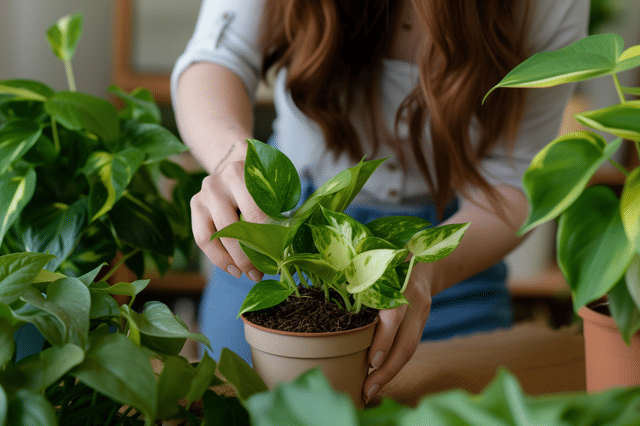
Taking care of a Golden Pothos isn't just about water and sunlight. You're also giving them a pleasant environment that supports their growth. This includes a properly sized pot. If you're unsure when to repot or how to do it, look out for these signs:
- Roots peeking out of the pot's drainage holes
- Soil that dries out within a few days
- Stunted growth
If you see any of these signs, it's time to repot your Pothos. On average, aim to repot every 2 years to keep your Golden Pothos thriving.
Let's Get Repotting
So have you seen your plant is ready to be repotted? You can follow these steps to easily repot your Pothos to give it more room to grow.
- Gently squeeze the pot to loosen the roots from the pot
- Pull the plant carefully out of the pot
- Inspect the roots. White and firm? All good. Brown and squishy? Time to trim.
- Pick a pot that's one size larger and make sure it has drainage holes.
- Fill the bottom of the new pot with fresh potting mix.
- Gently place your plant in the new pot and surround it with soil. Gently compact the soil to remove any air pockets, but not too tightly.
- Water your freshly potted Pothos
Use a well-draining soil with sphagnum moss and perlite for aeration and light, fluffy soil. This helps the plant to not get overwatered in its larger pot.
Propagating a Golden Pothos
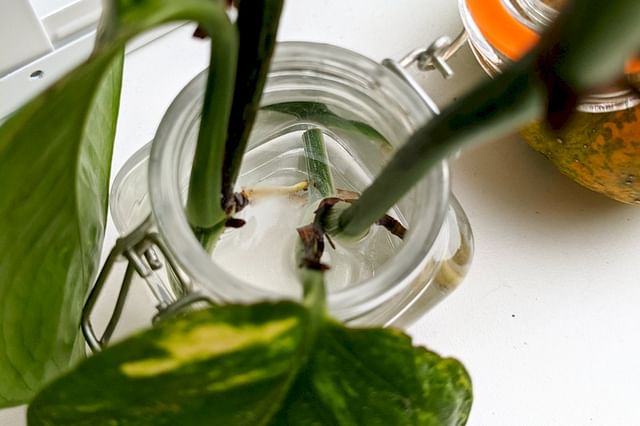
Propagating a Golden Pothos is easy, as its vines naturally start growing air roots. These air roots grow out of nodes in the vines of your Golden Pothos. New leaves also grow out of these little nodes in the vines. In the picture above, you can see where the leaves come out of the vines, little air roots also stick out.
If you want to propagate your Golden Pothos, you can make use of the fact that the roots and new leaves grow out of nodes in the vines. You can cut the vines about 2.5 cm (1 inch) under the node, and stick that right back into the soil. New roots will start to grow from the vines and in a few weeks, you'll have a new Golden Pothos growing in your house.
The best time to propagate your Pothos is during the growing season: spring and summer. During this time, your houseplant will recover quickly and will start to grow and settle into its new environment more quickly.
Propagation is a great way to make your Pothos look fuller and bushier, but also to keep your Golden Pothos under control. It grows very quickly, so trimming it and propagating it is a good way to keep it from taking over your living room.
Variegation maintenance
Golden Pothos are known for their beautiful variegation. The variegation is those marbled white/yellow patches on the green leaves. It's like each leaf is a unique piece of art, isn't it? But here's a fun fact: variegation isn't just about good looks. It's a result of a lack of chlorophyll in some cells, which means those white spots on the leaves are more than just pretty-they're pretty interesting, too!
Caring for a variegated plant can be a little trickier than their all-green buddies because you need just the right light to keep the patterns clear and vibrant. But don't worry, we'll look at care tips, so you can keep the variegation vibrant and stunning.
How do I keep the variegation vibrant?
To maintain the vibrant variegation on your Golden Pothos, you must provide it with the right balance of light and care. Here are some tips to keep those variegated leaves looking their best.
Provide the plant with bright, indirect sunlight. If it's getting direct sunlight, it'll start to get sunburns and if the sunlight is too little, it'll slowly lose the variegation. The leaves will turn back to green if the light isn't bright enough.
Besides light, you'll need to regularly fertilize the plant. The variegated leaves can perform less photosynthesis to feed the plant, so you'll need to keep up with fertilizing the plant to give it enough energy to stay healthy.
Last but not least, make sure to pay attention to pests. If the plant is stressed it can't maintain the variegation and will drop those leaves.
By taking these steps, you should see the variegation stay bright throughout the year.
Common problems and solutions for Golden Pothos
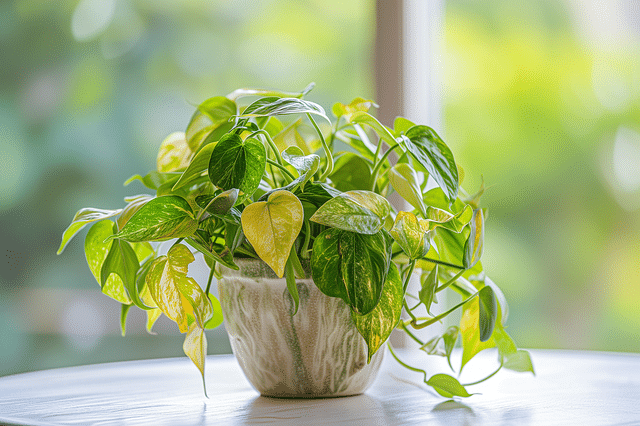
Golden Pothos is known for its hardiness and ease of care. But, like all plants, they can have some common issues that you'll need to deal with. Here are the most common things you'll likely have to deal with when taking care of your Pothos.
Yellow leaves
Overwatering is often the cause of yellow leaves. Make sure the plant has well-draining soil and that you're allowing the soil to dry out between waterings. Check the pot for proper drainage holes. Underwatering can also cause yellow leaves, but that's less common.
Brown, crispy Leaves
This usually indicates that the air is too dry or the plant is receiving too much direct sunlight. Try moving your pothos to a location with indirect light and maintain a consistent watering schedule. You can also increase humidity around the plant by misting it or placing a humidifier nearby.
Leaf drop
If your pothos is losing leaves, it might be due to a sudden change in temperature or light conditions. Gradually acclimate your plant to new environments, avoid drafts, and stabilize the temperature.
Pests
Common pests like spider mites, mealybugs, and scale can infest Pothos. Treat infestations with insecticidal soap, neem oil, or by wiping the leaves with alcohol-dipped cotton swabs. Quarantine the infested plant to prevent spreading to others.
Root rot
This condition occurs when there's excessive moisture due to overwatering or poor drainage. Signs include a mushy stem base and a foul smell from the soil. To resolve this, trim the affected roots, and repot the plant in fresh, well-draining soil.
You can prevent root rot for your Pothos by letting the top of the soil dry out, growing your plant in a pot with drainage holes, and using well-draining soil. This will let the roots of your plant breathe, which helps to prevent root rot.
Leggy vines
Lack of light can cause the plant to grow long, spindly stems. Move your pothos closer to a light source or consider adding a grow light if necessary, and prune back the leggy vines to encourage bushier growth.
Pale or bleached leaves
This could indicate direct sun exposure which pothos plants generally do not tolerate well. Relocate your plant to an area with indirect or filtered light.
Drooping leaves
If the leaves on your Golden Pothos start drooping, it could be a sign of underwatering. It's the plant's way of telling you it needs more water to survive. However, if the soil is wet but your Pothos still has drooping leaves, it could be a sign of overwatering and root rot.
Winter care for your Golden Pothos
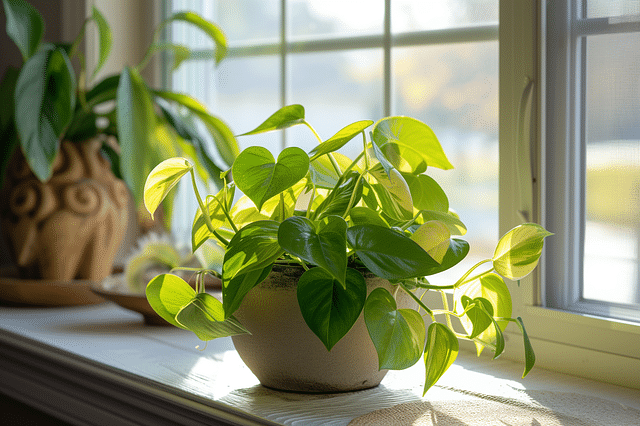
During winter, cut back on watering your Golden Pothos since its water needs decrease with cooler temperatures and shorter days. Ensure the soil is dry an inch down before adding water to avoid root rot. Place the plant in a spot with bright, filtered light away from direct sun to prevent leaf scorching; use grow lights if natural light isn't sufficient.
Keep your Pothos away from cold drafts and excessive heat, maintaining warm indoor conditions. No need to fertilize until growth resumes in spring. Regularly check for signs of stress or pests to keep your plant healthy and prepared for active growth when warmer weather arrives.
Pest prevention and control
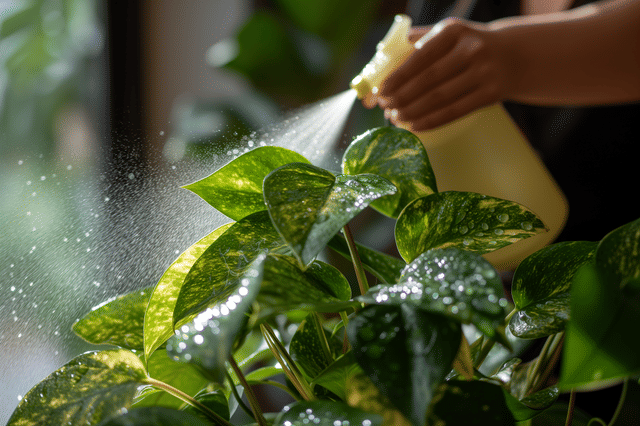
Golden Pothos plants are prone to pests such as mealybugs, spider mites, and scale insects. You can identify them by the fine webs, white cottony masses, and small brown bumps they leave on your plant. Regularly inspect for these signs and any sticky residues or visible pests with the help of a magnifying glass to spot them early.
When you spot the pests, immediately treat your plant. For minor infestations, use a cloth moistened with alcohol to remove mealybugs and scale insects, and rinse spider mites away with water, being careful not to damage the plant. For more severe cases, apply insecticidal soap or neem oil according to the instructions on the label. Make sure to cover the whole plant, as well as the bottom of the leaves. You might need to treat these pests several times.
How can I prevent pests from infesting my plant in the first place?
Preventing pests from infesting your Golden Pothos takes a bit of effort. Buy healthy plants from reputable sources and inspect them for pests. Quarantine new plants to protect existing plants when you bring them home. Clean leaves regularly to wipe away dust and possible pests, and space plants to improve airflow and reduce moisture, making the environment less inviting to insects.
Water wisely. Let the soil's top inch dry out before watering to prevent stress and keep moisture-loving pests away. Fertilize during the growing season to strengthen your Pothos against infestations. Regularly check for pests, particularly under leaves and on new growth, to catch early signs of trouble.
Use natural products like neem oil as a preventive measure by applying it to your plant according to the instructions. Keep your plant tools clean, sterilizing them after contact with infestations. By paying close attention to your plant, you can catch any pests early on and treat your plant.
Toxicity
Unfortunately, like many other tropical plants, a Golden Pothos is poisonous to pets and humans. The plant is poisonous when eaten or when you've touched the sap, as the plant contains insoluble calcium oxalate crystals. These crystals are very sharp and cause irritation on your skin or in your mouth when eaten.
If your pets have been eating this plant, make sure to call your veterinarian right away to prevent any more harm and pain for your pets. It's not just harmful for your pets, but also for humans, so make sure to keep this plant out of reach of your small children too.
Conclusion
The Golden Pothos is a gorgeous plant that will instantly give you a jungle feeling in your house. It's not the easiest houseplant to take care of, but it's also not very difficult. This houseplant will show you when it's not happy, but it does require a little bit more care than a succulent or Sansevieria.
Your Golden Pothos loves bright indirect light and likes to grow in moist, but well-draining soil at all times. You can propagate your Pothos in the growing season and you should fertilize it about once a month during this time. Unfortunately, this plant is poisonous to pets and humans, so make sure to keep it out of reach of children and animals.
If you follow the care tips mentioned above, your Golden Pothos will thrive and grow into a beautiful lush houseplant that will make your home feel like a tropical paradise!
Thank you for reading this post! I hope it helps you to keep your plants healthy and beautiful! If you're looking for more guides on specific plants, you can always request a plant guide to get a guide for the plant you have trouble with.
Test your plant care knowledge
Quiz completed!
Want to learn more? Sign up for my newsletter to receive free tips in your inbox!
Sign up now!
